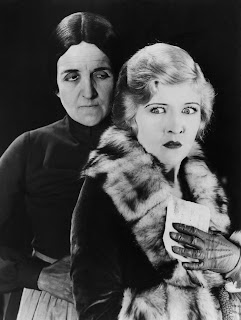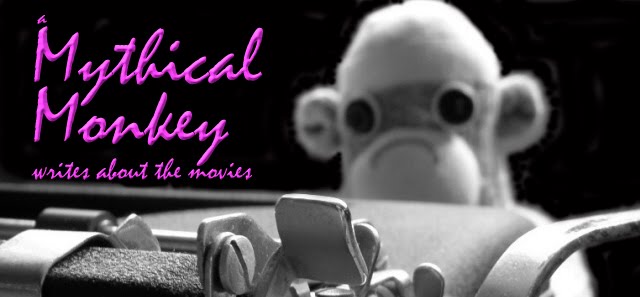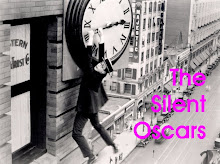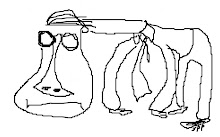 While many great films have come out of Universal Studios since its founding in 1912, the genre with it is most associated is and probably always will be horror. From silent era films starring Lon Chaney, to Bela Lugosi and Boris Karloff during the early sound era, right up to Drag Me To Hell and Shaun of the Dead in the 21st century, the Universal logo at the beginning of a film promises a viewer 90+ minutes of scary thrills and chills.
While many great films have come out of Universal Studios since its founding in 1912, the genre with it is most associated is and probably always will be horror. From silent era films starring Lon Chaney, to Bela Lugosi and Boris Karloff during the early sound era, right up to Drag Me To Hell and Shaun of the Dead in the 21st century, the Universal logo at the beginning of a film promises a viewer 90+ minutes of scary thrills and chills.You no doubt have your own favorites, but I prefer the horror films of directors Tod Browning (Dracula) and James Whale (Frankenstein) who worked during the late silent and early sound eras. They didn't just work in the genre, they defined it, inventing many of the visual and narrative cliches we love and demand when we wait in the dark to be scared out of our wits.
As great and influential as those two directors were, however, it was their contemporary, the German Paul Leni, who might have been Universal's greatest director of horror. He was responsible for three of the best horror films of the silent era, Waxworks and The Man Who Laughed—both starring Conrad Veidt, who you may better know as Casablanca's Major Strasser—and this one, The Cat and the Canary, which like The Man Who Laughed was filmed on the Universal backlot.
The plot of The Cat and the Canary has been recycled so many times, I scarcely need describe it—an eccentric millionaire leaves a will stipulating it not be read until the twentieth anniversary of his death, a will which when read names his sweet niece Annabelle as sole heir, provided she survive a night in his spooky old mansion.
I spent a year in law school studying decedents' estates and trusts—wills, to you—and let me tell you, this is one nutty way to pass money from one generation to the next.
 Add in a houseful of greedy relatives, a stormy night and the fact that the will itself has been tampered with—the old man's lawyer opens the safe for the first time in twenty years only to find a still-living moth flapping its wings inside—and you've got yourself the making of a nifty, old-fashioned ghost story.
Add in a houseful of greedy relatives, a stormy night and the fact that the will itself has been tampered with—the old man's lawyer opens the safe for the first time in twenty years only to find a still-living moth flapping its wings inside—and you've got yourself the making of a nifty, old-fashioned ghost story.The cast is populated with unknowns—other than Tully Marshall and Lucien Littlefield, I wasn't familiar with any of them—and the story itself is a hoary old chestnut, but with Leni's expert direction taking full advantage of Charles Hall's set design, the film is a treat from beginning to end, moving like lightning, and fun and spooky in a kids telling ghost stories on Halloween kind of way.
 The film is a fine example of what the Germans called "Expressionism"—an attempt to represent the world in subjective terms, that is to say, distorted to reflect an emotional state rather than an objective one—and as such films as The Cabinet of Dr. Caligari, Nosferatu and this one demonstrate, is well suited to evoking the heightened emotional state necessary for true horror.
The film is a fine example of what the Germans called "Expressionism"—an attempt to represent the world in subjective terms, that is to say, distorted to reflect an emotional state rather than an objective one—and as such films as The Cabinet of Dr. Caligari, Nosferatu and this one demonstrate, is well suited to evoking the heightened emotional state necessary for true horror. Working with Hall, who later created sets for Frankenstein, Dracula and Bride of Frankenstein, Leni designed a mansion that looks like a cross between Charles Foster Kane's Xanadu and Dracula's lair, a backlit castle more suited to Transylvania than the Hudson River valley, full of impossible corridors narrow yet three stories high with curtains billowing from open windows; massive doors that look like they were carved whole from ancient oaks; chairs big enough to seat Goliath; acres of cobwebs; hidden passages; secret panels; and all of it lit from below as if told by half-frightened, half-giggling kids with a flashlight during a sleepover.
Working with Hall, who later created sets for Frankenstein, Dracula and Bride of Frankenstein, Leni designed a mansion that looks like a cross between Charles Foster Kane's Xanadu and Dracula's lair, a backlit castle more suited to Transylvania than the Hudson River valley, full of impossible corridors narrow yet three stories high with curtains billowing from open windows; massive doors that look like they were carved whole from ancient oaks; chairs big enough to seat Goliath; acres of cobwebs; hidden passages; secret panels; and all of it lit from below as if told by half-frightened, half-giggling kids with a flashlight during a sleepover. "I have tried to create sets so stylized that they evince no reality," Paul Leni explained in 1924. "[It] is not extreme reality that the camera perceives, but the reality of the inner event, which is more profound, effective and moving than what we see through everyday eyes."
"I have tried to create sets so stylized that they evince no reality," Paul Leni explained in 1924. "[It] is not extreme reality that the camera perceives, but the reality of the inner event, which is more profound, effective and moving than what we see through everyday eyes."Unfortunately, Leni died suddenly in 1929 at the age of forty-one, and his name and his films, along with most of the silent era, was quickly forgotten by a movie-going public hungry for the next big thing, talkies.
 But even if Leni himself has been forgotten, his influence hasn't. The film was a huge hit, critically and commer-cially, and has been remade at least five times, the best of them starring Bob Hope. It has also been copied and ripped off, in one form or another, too many times to count, including as The Old Dark House featuring Boris Karloff and Charles Laughton, The Laurel-Hardy Murder Mystery, with, yes you guessed it, Laurel and Hardy, and If a Body Meets a Body starring the Three Stooges.
But even if Leni himself has been forgotten, his influence hasn't. The film was a huge hit, critically and commer-cially, and has been remade at least five times, the best of them starring Bob Hope. It has also been copied and ripped off, in one form or another, too many times to count, including as The Old Dark House featuring Boris Karloff and Charles Laughton, The Laurel-Hardy Murder Mystery, with, yes you guessed it, Laurel and Hardy, and If a Body Meets a Body starring the Three Stooges.But don't take my word for it—watch it here yourself, courtesy of the Internet Movie Database and Archive.org, and reflect as you do, just how many times you've seen it, even if you've never seen it.







5 comments:
Great post! I haven't seen this since I accidentally caught it on TCM back in the 1990s. Charles Hall appears to have been a hell of a set designer; until this blogathon I hadn't even heard of him, he was just a name in the credits, but I've come away with quite an appreciation for him. And I'll be checking out more of Paul Leni's films, too.
Great, detailed post, I'll definitely check this out when I get a chance. In a roundabout way, our Universal Backlot Blogathon posts are related. Mine was about the Spanish-language Dracula, which starred Lupita Tovar, who previously starred in the Spanish-language remake of The Cat and the Canary. Thanks for this :)
I thought both of you wrote great pieces for the Backlot Blogathon. I knew your work going in of course, Stacia, but I don't think I'd seen your blog before, Paula, and I've added it to my blog roll.
Hey there! Sorry to be one of THOSE people but the photo used for Leni is actually Hobart Bosworth.
Sorry to be one of THOSE people but the photo used for Leni is actually Hobart Bosworth.
Thanks! I had corrected that on my Alternate Oscars list, but forgot I had originally posted it here. Don't know how that picture got mislabeled in my files in the first place. I blame silent film gremlins.
Post a Comment